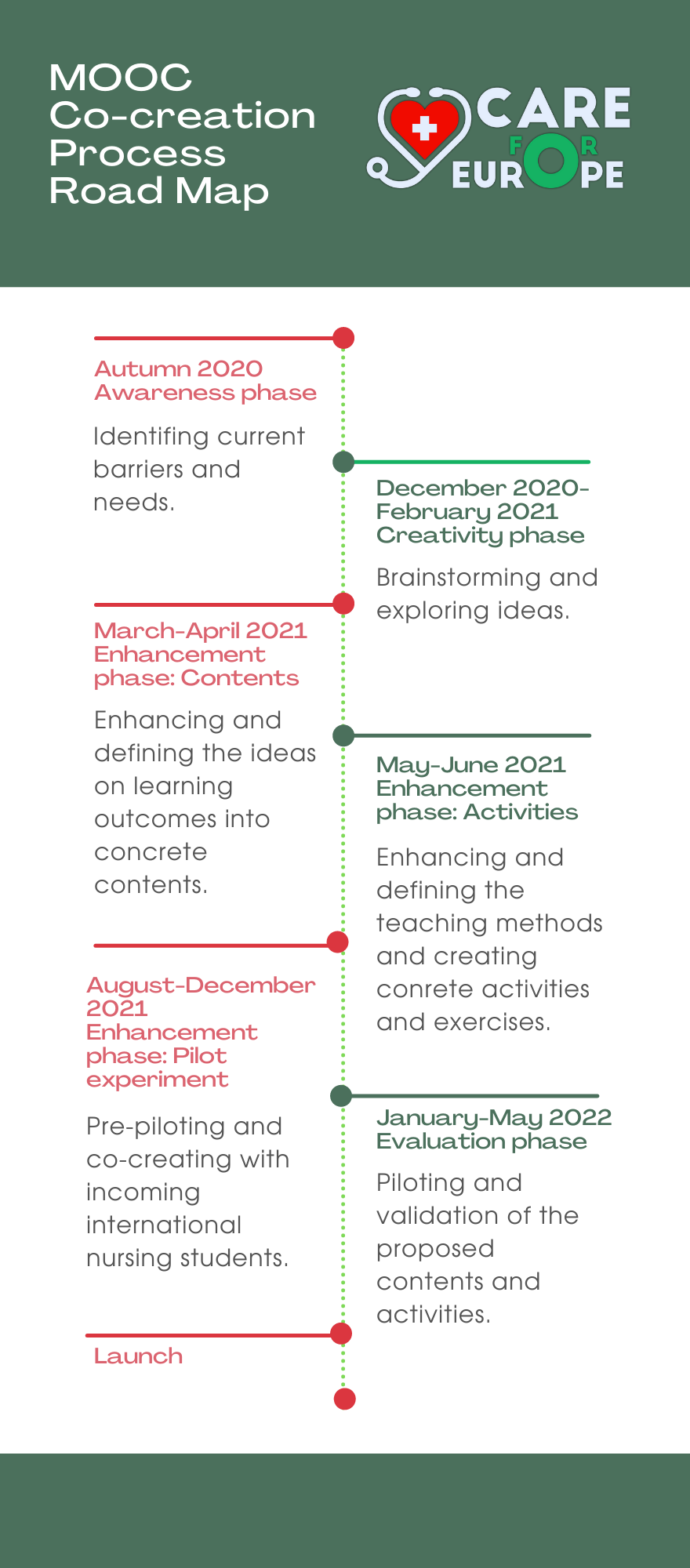Nursing professions are increasingly concerned with globalization when patients are coming from all over the world and representing various different cultures. Moreover, nurses themselves work in multicultural teams in their clinical environments, and would greatly benefit from an educational intervention in intercultural communication competence already during their studies.
 Picture: Unsplash
Picture: Unsplash
Care for Europe Erasmus+ KA2 project aims to internationalize nursing education through a better integration of incoming nursing students during their studies and clinical placements in the receiving countries. It brings together four higher education institutions from four European countries: the French Red Cross IRFSS Auvergne-Rhône-Alpes in France, University of Pécs in Hungary, Universitat de Lleida in Spain and Laurea University of Applied Sciences in Finland. The cultural diversity of these four participants located in four different European regions has resulted in rich exchanges allowing the comparison of visions, cultures and care practices.
In order to achieve the integration goal and implement the project, the four partners co-create innovative pedagogical tools. These tools are a MOOC (Massive Open Online Course) to support the integration of international nursing students into their clinical placements, a good practices guide for professionals who are involved in clinical placements, as well as short films recounting the experiences of incoming nursing students. The digital material created in this project aims to describe working as a nurse as well as clinical environments, thus providing a realistic nurse’s job description in the receiving country. All the project outputs are designed applying various co-creation methods in order to engage and empower all the project partners. The authors MBA student Anna Lintunen and Project Specialist Sari Myréen were involved in creating a roadmap for this co-creation process.
What is a Massive Open Online Course?
MOOCs are usually focused on specific subjects in a comprehensive way. MOOCs offer higher education for all and they have changed the game for many people that did not have access to it before. MOOCs can usually be divided into two groups: connectivist MOOCs (cMOOCs) and well-financed MOOCs (xMOOCs). In cMOOCs the idea is that people connect with each other to form a knowledge network. In that network, they can share knowledge and experiences and learn from each other. xMOOCs use pre-efforts and money investments to create the content which is planned well and can be compared to normal academical courses. There are many reasons why MOOCs are so popular, and their success has been rapidly increasing. There is an ongoing change and development going on in corporations and people have to keep up by upgrading their knowledge. The technological development in connectivity and mobility has opened up possibilities for the MOOCs to spread around globally. Of course, the low cost of MOOCs compared to other education is also one of the main reasons why MOOCs have had such a massive success. (Sharif & Guilland, 2015)
Measuring the success of a MOOC can be challenging. The average completion rates of MOOCs can be very low. Both cMOOCs and xMOOCs have high dropout rates although their teaching methods vary from each other. However, the completion rate does not necessarily tell anything about the success of a MOOC. People can join in a MOOC with zero commitment anytime even if it has already started. This allows people with different learning goals to join and fulfil their needs. There are students who just want to learn about a specific topic with no intention to complete the whole course. Some students just want to participate in the discussions and network with others. And finally, there are students whose goal is to complete the course. The values of MOOCs should be studied by searching information from the students’ point of view, because understanding their needs, goals, behaviour and expectations helps with developing the MOOC further so that it benefits its users the best way possible. (Sharif & Guilland 2015)
Why co-creation?
Co-creation brings together different sectors related to service or a product. The purpose is to solve needs and problems related to a service or a product, which are being created. The idea is to put customers at the forefront and with cooperation develop the services and products that customers truly value. Two or more sectors together discuss developmental needs and ways to approach the issue and solve the problem behind it. All the participants have the same goal, but they approach the problem from their own perspective. Co-creation offers tools to develop customer-oriented services by using multi-actor cooperation in a productive way. (Kauppinen, Kesäniemi, Luojus, Lange & Lönn 2020)
Co-creation as a method suits well in an uncertain situation that may require quick change in plans. Co-creation process must be carried out in a way that benefits all the actors who are participating. The main problem is to maintain the co-operation between several actors and the co-operation process. The core of the co-creation process is to find out the needs and goals of the actors involved and matching them with the expected benefits on the practical level. If there are rules that everyone has agreed on, it helps the development process and eventually brings benefits to all participants. (Hagman, Hirvikoski, Wollstén & Äyväri 2018)
 MOOC co-creation process (Myréen & Lintunen 2021)
MOOC co-creation process (Myréen & Lintunen 2021)
Roadmapping the Care for Europe MOOC co-creation process
Observation phase
The first step in the MOOC co-creation process was to gather all partners together so that they could start to observe potential barriers and needs for the MOOC in their respective countries. To launch the cooperation for innovation and exchange of good practices, a training activity on how to develop the mentoring and integration of nursing students from another culture into a clinical environment was organised online coordinated by Laurea University of Applied Sciences. In the training activity workshops, the participants discussed various themes that could later be included in the MOOC. On the second training day, the participants familiarised themselves with the research findings of Professor Kristina Mikkonen and researcher Ashlee Oikarainen from the University of Oulu in Finland, who shared their profound knowledge of the integration of culturally and linguistically diverse nursing students into healthcare organisations as well as their expertise in cultural competence education for mentors.
The participants also had a change to have a workshop on professional language skills for nursing with researcher Inkeri Lehtimaja who provided them with useful tips and recommendations on how to support students’ foreign language learning during clinical placement. On the third day, there was an interesting opportunity to retrace an Erasmus student’s internship path in the clinical environments of the project coordinator IRFSS AuRA in France, during which the participants could experience through many testimonies how rewarding it can be to have an international trainee on the ward, both from the professionals’ and patients’ perspectives. On the fourth training day, the participants became familiar with the Hungarian partners, the University of Pécs and PhD Orsolya Máté’s studies on transcultural nursing as well as PhD Klára Simon’s case studies on communicational incidents in health care. The participants could find many similarities in their countries regarding the minorities in health care, such as challenges in communication due to the respect for the elderly and traditional gender roles as well as different health practices that could be avoided by developing mutual understanding. On the last training day, the participants could travel virtually to Spain to meet several healthcare professionals from the University of Lleida and listen to their testimonies. The project’s first training activity served as a very important starting point for the intellectual outputs and provided the project partners with evidence-based material for their future work.
Imagination phase
The next phase in the MOOC process was the imagination phase, when the partners received more information about MOOCs and co-creation as a concept. The idea was to brainstorm and explore all ideas so that the best ideas would come out and could be put into use. Different kinds of MOOCs were introduced and the module themes and end users of the MOOC were defined during this phase.
Refinement phase
In March 2021, the project moved to the refinement phase when the teams started to refine the defined ideas into concrete contents. The goal was to gather information from each participant country for the first MOOC modules. In the first version of the MOOC, the aim of Module 1 was to introduce the concept of interculturality in care from the theoretical viewpoint. The theories presented by the partner countries reflected the current constructivist view on intercultural competence, which defines culture through interactions among people. The theoretical framework thus discussed culture as a concept, which evolves continuously adapting to the realities experienced by its members. The aim of Module 2 was to welcome culturally and linguistically diverse nursing students to the clinical environment in the receiving country. It would later also include an innovative 360-image virtual reality platform where the MOOC content would be placed on 360-images taken in the clinical environments in each partner country. Module 3 would help students integrate better to the new clinical environment through various activities placed on the virtual reality platform. In Module 4, the aim was to teach the students professional language for clinical settings with different interlocutors in the receiving country. Module 5 was for the students’ assessments and self-evaluation after their clinical placement. The aim was to evaluate their learning process and what intercultural knowledge they had gained during the placement.
The teams from the four different countries familiarised themselves with each other’s material so that the theoretical content was clear for all. The teams decided to create Personas for the students and write User Stories about the students, which helped them to define who would be their students, what they would need to teach to them and how they should do that. This method was applied so that the teams could more easily evaluate the MOOC from the students’ point of view. In the piloting phase the MOOC was further developed with incoming international students in each country through various research methods.
Assessment phase
The last phase of this co-creation project will be the assessment phase, which is planned to take place in spring 2022. In this phase, the final version of the MOOC can be tested with different target groups. When this is done, it is time to validate the MOOC and launch the final product.
Conclusion
Clinical environments provide very complex learning environments for international nursing students. Learning in a clinical setting happens in real-life situations in interaction with the local nursing staff and patients in the receiving countries. These environments are also becoming increasingly multicultural in Europe. Nursing students from different cultures often face the greatest challenges of their education when they complete their clinical practice, because facing cultural differences, especially at the beginning of practice, can cause feelings of anxiety and hopelessness (Mikkonen et al. 2021). Taking into account the aforementioned complexities, educational interventions in intercultural communication competence already during nursing education would be highly beneficial for future nursing professionals.
References:
- Hagman K., Hirvikoski T., Wollstén P., Äyväri A. 2018. Handbook for Co-creation. City of Espoo.
- Kauppinen, S., Kesäniemi, E., Luojus, S., Lange, P. & Lönn, N. 2020. From need to solution – Co-creation handbook for social welfare and health care. Forum Virium Helsinki and Laurea University of Applied Sciences.
- Laurea News Interculturality in care – Developing international nursing students’ clinical placement through an Erasmus+ project 23.2.2021. Retrieved at: https://www.laurea.fi/en/current-topics/artikkelit/interculturality-in-care–developing-international-nursing-students-clinical-placement-through-an-erasmus-project/
- Mikkonen. K. et al. (Eds.) 2021. Advanced Mentorship Competences, Modules I – III of Advanced Mentorship Competences. Retrieved at: https://www.qualment.eu/wp-content/uploads/2021/10/Advanced_Mentorship_Competences_QualMent_final.pdf
- Sharif, M. & Guilland, A. (2015) Massive Open Online Courses – Promoting Engagement Through Means of Gamification. In L. Gómez Chova, A. López Martínez & I. Candel Torres (Eds.) EDULEARN15 Proceedings. IATED Academy, 7049-7055.